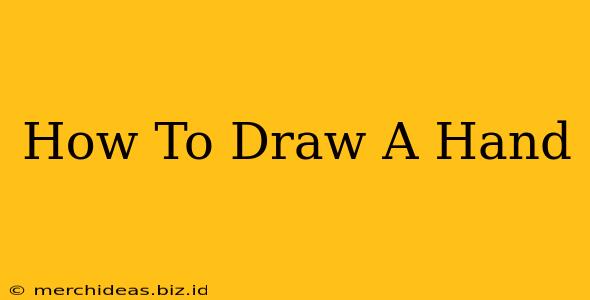Drawing hands can be intimidating, even for experienced artists. They're complex, with many moving parts and subtle nuances. But don't worry! This guide breaks down the process into manageable steps, making it easy for beginners to learn how to draw a hand realistically. We'll cover everything from basic shapes to adding detail and capturing realistic proportions.
Understanding Hand Anatomy: The Foundation of Realistic Drawing
Before you even pick up your pencil, it's helpful to understand the basic anatomy of a hand. This will significantly improve your ability to draw realistic hands.
Key Elements to Observe:
- Palm: The fleshy base of your hand. Think of it as a slightly irregular, flattish shape.
- Fingers: Each finger consists of three sections (phalanges), with the thumb having only two. Notice the slight tapering of the fingers as they approach the tips.
- Thumb: The thumb is unique, moving independently of the other fingers. Observe its position and angle relative to the palm.
- Knuckles: The joints where the fingers bend. These are crucial for showing movement and pose.
- Wrinkles and Lines: Hands naturally have wrinkles and lines, especially on the back of the hand. These details add realism and character.
Step-by-Step Guide to Drawing a Hand
Now, let's get started with the drawing process itself. We'll use a simplified approach to make it accessible to everyone.
Step 1: Simplify with Basic Shapes
Start by sketching out the basic shapes of the hand using simple geometric forms. Think of the palm as a rectangle or trapezoid, and the fingers as elongated rectangles or cylinders. This simplifies the complexity and helps you establish the overall structure.
Step 2: Refine the Outline
Once you have the basic shapes in place, start refining the outline. Pay attention to the curves and angles of the palm and fingers. Soften the hard edges of your initial shapes to create a more natural look. Don't be afraid to erase and redraw until you're satisfied with the overall form.
Step 3: Add the Knuckles and Finger Joints
Carefully add the knuckles and finger joints, paying close attention to their placement and how they affect the overall shape of the hand. These joints are crucial for conveying the hand's movement and position.
Step 4: Detailing the Hand
Now it's time to add detail! This is where you bring your drawing to life. Add subtle wrinkles, lines, and creases to the palm and fingers. Pay attention to the way light and shadow interact with the surface of the hand to enhance realism.
Step 5: Adding Shadows and Highlights
Use shading and highlights to give your hand drawing depth and dimension. Observe how light falls on the hand and where shadows are cast. Use this information to add shadows and highlights strategically, bringing your drawing to life.
Tips for Improving Your Hand Drawings
- Practice Regularly: The key to improving your hand drawings is practice! The more you draw, the better you'll become at capturing the subtleties of the hand's form and movement.
- Use References: Study real hands. Use photos or even your own hand as a reference to accurately capture proportions and details.
- Experiment with Different Poses: Try drawing hands in different positions and gestures to improve your understanding of their anatomy and flexibility.
- Don't Be Afraid to Erase: Drawing is a process of trial and error. Don't be discouraged if your initial sketches don't look perfect. Erase and redraw until you achieve the desired result.
Mastering the Art of Hand Drawing
Drawing hands realistically takes time and practice, but by following these steps and tips, you can significantly improve your skills. Remember to be patient with yourself and enjoy the process of learning! With dedication and persistence, you'll be amazed at how much you can improve your hand drawings over time.
